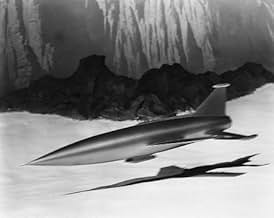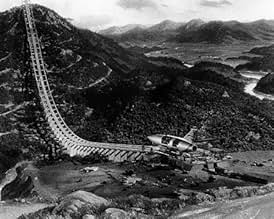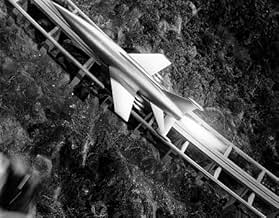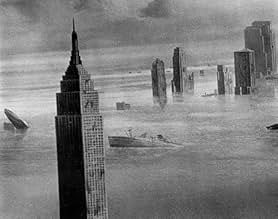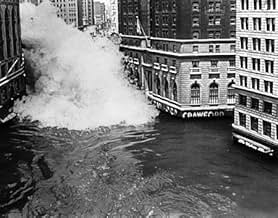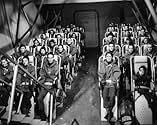CALIFICACIÓN DE IMDb
6.6/10
10 k
TU CALIFICACIÓN
Mientras una nueva estrella y un nuevo planeta se precipitan hacia una Tierra condenada al fracaso, un pequeño grupo de supervivientes trabaja frenéticamente para completar el cohete que los... Leer todoMientras una nueva estrella y un nuevo planeta se precipitan hacia una Tierra condenada al fracaso, un pequeño grupo de supervivientes trabaja frenéticamente para completar el cohete que los llevará a su nuevo hogar.Mientras una nueva estrella y un nuevo planeta se precipitan hacia una Tierra condenada al fracaso, un pequeño grupo de supervivientes trabaja frenéticamente para completar el cohete que los llevará a su nuevo hogar.
- Dirección
- Guionistas
- Elenco
- Ganó 1 premio Óscar
- 2 premios ganados y 1 nominación en total
Peter Hansen
- Dr. Tony Drake
- (as Peter Hanson)
Rachel Ames
- Julie Cummings
- (as Judith Ames)
Kirk Alyn
- Rioter Bringing Guns
- (sin créditos)
Gertrude Astor
- Traveler
- (sin créditos)
Mary Bayless
- Club Patron
- (sin créditos)
Nina Borget
- Translator
- (sin créditos)
Steve Carruthers
- Delegate
- (sin créditos)
Robert Chapman
- Student
- (sin créditos)
Gene Collins
- Newsdealer
- (sin créditos)
James Congdon
- Eddie Garson
- (sin créditos)
- Dirección
- Guionistas
- Todo el elenco y el equipo
- Producción, taquilla y más en IMDbPro
Opiniones destacadas
Loved this movie!......remember, this was 1951 so don't expect the computer generated special effects that we enjoy today. The roller coaster rocket ship take-off is like something from a comic book but, again, remember when this was made.....who knew about rockets to outer space? Richard Derr, whoever he was, is OK in the lead but seems a little bit laid back for someone who knows the world is going to end with a bang. In fact, most of the cast, seems rather off-hand until the very end when the chips are down and decisions are being made as to who lives and who gets to stay for the big one. There are a lot of familar faces (except for Derr) in this movie although they are mostly second leads and not "stars". Look for some walk-ons from actors on their way down and on their way up......John Ridgely who was a staple in WWII films, Kirk Alyn, Superman from the old serials, and Stuart Whitman who would go on to play some decent roles in the 60's and 70's. This film may not be "Independence Day", but it is the best of the early doomsday/futuristic movies of the time.
George Pal, Hungarian born Puppetoon creator and fantasy legend made several great science fiction space movies. Adaptations of popular books in the 50's included former German rocket scientist Willy Ley's "Conquest Of Space" using designs and ideas illustrated by space artist Chestley Bonestell, who's work is seen in almost all of Pal's space films in one way or another, considered cutting edge for the time. His others included H.G.Wells classic "War Of The Worlds", Robert Heinlein's "Destination Moon" and the Edwin Balmer & Philip Wylie 1932 novel "When World's Collide".
The results still stand as seminal classics of science fiction filmwork, often copied, referenced and paid homage in one way or another. Although perhaps dated by the computer generated, digitally enhanced SFX of today's so-called masterpieces, these films still stand out as the major influences which helped shape our dream, visions and often spoke to our deepest fears, such as the end of the world.
From the inverted ski jump launch system (used today on aircraft carriers), to expendable booster rockets (a Space Shuttle standard), the Ark spaceship spawned the imagination of many filmakers, including some who reused the model for other films such as "Flight To Mars" and "The Queen Of Outer Space". The movie still stands as a milestone as the first science fiction disaster movie.
Once again, Leith Stevens' musical score enriches the experience, as it did for Pal's previous space adventure, "Destination Moon". The film's special effects won it the Oscar in 1951. All this, and in the rich tones of Technicolor that shall never been seen in a first run movie theater again. Thank you Lord for revival houses that still manage to seek out old time prints for festivals (the Alamo Drafthouse in Austin, Texas comes to mind).
There still remains a bit of controversy, though, about the film's ending. A wide, panoramic Bonestell matte painting is seen from the hatch of the newly arrived Ark. In the image can be seen two clearly pyramidal mountains in perfect proportions, as if artificial, as well as the base of what appears to be a building constructed by an alien intelligence. Although the actors don't react to this (the matte effect added in post production), the artwork hints at the planet Zyra as being inhabited (In the novel, the planet is known as Bronson Beta, and is indeed found to be once inhabited, and is explored further in the sequel "After Worlds Collide").
In the 1970s, producers Richard Zanuck and David Brown attempted to do a remake, which eventually mutated into the 1998 film, "Deep Impact". As in "When Worlds Collide", the human interaction was as important as the science fiction elements.
The results still stand as seminal classics of science fiction filmwork, often copied, referenced and paid homage in one way or another. Although perhaps dated by the computer generated, digitally enhanced SFX of today's so-called masterpieces, these films still stand out as the major influences which helped shape our dream, visions and often spoke to our deepest fears, such as the end of the world.
From the inverted ski jump launch system (used today on aircraft carriers), to expendable booster rockets (a Space Shuttle standard), the Ark spaceship spawned the imagination of many filmakers, including some who reused the model for other films such as "Flight To Mars" and "The Queen Of Outer Space". The movie still stands as a milestone as the first science fiction disaster movie.
Once again, Leith Stevens' musical score enriches the experience, as it did for Pal's previous space adventure, "Destination Moon". The film's special effects won it the Oscar in 1951. All this, and in the rich tones of Technicolor that shall never been seen in a first run movie theater again. Thank you Lord for revival houses that still manage to seek out old time prints for festivals (the Alamo Drafthouse in Austin, Texas comes to mind).
There still remains a bit of controversy, though, about the film's ending. A wide, panoramic Bonestell matte painting is seen from the hatch of the newly arrived Ark. In the image can be seen two clearly pyramidal mountains in perfect proportions, as if artificial, as well as the base of what appears to be a building constructed by an alien intelligence. Although the actors don't react to this (the matte effect added in post production), the artwork hints at the planet Zyra as being inhabited (In the novel, the planet is known as Bronson Beta, and is indeed found to be once inhabited, and is explored further in the sequel "After Worlds Collide").
In the 1970s, producers Richard Zanuck and David Brown attempted to do a remake, which eventually mutated into the 1998 film, "Deep Impact". As in "When Worlds Collide", the human interaction was as important as the science fiction elements.
This movie rocks!
Okay, I know it's dated. know what?? I Don't care! This kind of movie making would put half the people in Hollywood out of work today. Maybe that's not such a bad thing. They did it right in the early days. They had their priorities right:
Story first
Then characters
Then Special effects
Seems simple, doesn't it? How come they can't get it right today? (with few exceptions, of course). Nope, today it's Special effects, stars, then story.... in fact, even the stories aren't original!!!
This sums up why I like this movie so much and many like it from the same era. They're exciting, fun, and captivating. The kind of movie that leaves you thinking, dreaming, having nightmares, all in the name of fun. You're left dreaming of what it would be like, how you'd react, what you'd do. You'd sit and ponder about a new life on a new planet. And not once would the level of special effects tarnish your view of this gem.
When was the last time you felt that way coming out of a modern movie? My guess is a lonnnnnng time. There are very few exceptions today. The special effects in movies like "Worlds" was icing on the cake... BUT IT WAS THE CAKE THAT MATTERED! Today, it's all icing and the cake can't support it (crappy icing, in fact!!)
Eat your cake and have it too! Watch "When Worlds Collide"!
Okay, I know it's dated. know what?? I Don't care! This kind of movie making would put half the people in Hollywood out of work today. Maybe that's not such a bad thing. They did it right in the early days. They had their priorities right:
Story first
Then characters
Then Special effects
Seems simple, doesn't it? How come they can't get it right today? (with few exceptions, of course). Nope, today it's Special effects, stars, then story.... in fact, even the stories aren't original!!!
This sums up why I like this movie so much and many like it from the same era. They're exciting, fun, and captivating. The kind of movie that leaves you thinking, dreaming, having nightmares, all in the name of fun. You're left dreaming of what it would be like, how you'd react, what you'd do. You'd sit and ponder about a new life on a new planet. And not once would the level of special effects tarnish your view of this gem.
When was the last time you felt that way coming out of a modern movie? My guess is a lonnnnnng time. There are very few exceptions today. The special effects in movies like "Worlds" was icing on the cake... BUT IT WAS THE CAKE THAT MATTERED! Today, it's all icing and the cake can't support it (crappy icing, in fact!!)
Eat your cake and have it too! Watch "When Worlds Collide"!
When I was younger, this was one science fiction film that definitely made an impression on me. This was one of those where I actually was scared that one day my world would come to an end. However, as I got older I realized that this was just a movie, but still it is one of the best genre films of its era. Sure, it has its flaws (especially the painted background at the end), but still it is a film that was a product of its time and it will always be one of my favorites.
This is one of the least known sci-fi movies from the 1950s, but it's one of the best of the era. The great thing about this movie is that it concerns the lives of the characters and their personal problems.
The plot is about a group of researchers that after a trip in Africa discover some shocking news, that the star Bellus will collide to Earth, destroying the planet. Soon they begin to build a giant rocket ship that will take a group of survivors in Zyra, a safer planet.
The best part of the movie (for me) was the part of all the cataclysms (mountains crumbling, giant sea waves, the Brooklyn Bridge auto-destroying in pieces), and the music fits with the viewer's emotions. I also liked the chemistry between the two main characters (Richard Derr and Barbara Rush), especially in the night-club scene. And the ending is very superb for a 1951 sci-fi movie!
This is a sci-fi movie that every sci-fi fan must see almost once in their life.
The plot is about a group of researchers that after a trip in Africa discover some shocking news, that the star Bellus will collide to Earth, destroying the planet. Soon they begin to build a giant rocket ship that will take a group of survivors in Zyra, a safer planet.
The best part of the movie (for me) was the part of all the cataclysms (mountains crumbling, giant sea waves, the Brooklyn Bridge auto-destroying in pieces), and the music fits with the viewer's emotions. I also liked the chemistry between the two main characters (Richard Derr and Barbara Rush), especially in the night-club scene. And the ending is very superb for a 1951 sci-fi movie!
This is a sci-fi movie that every sci-fi fan must see almost once in their life.
¿Sabías que…?
- TriviaScreenwriter Bruce Joel Rubin saw this film as a ten-year-old, and has cited it as "the beginning of the emergence of philosophy" in his life. In The Dialogue: An Interview with Screenwriter Bruce Joel Rubin (2007), he explains that right after he and a boyhood friend saw the film, they spent hours discussing the end of the world. Rubin mentions this memory while explaining that Steven Spielberg approached him to do the screenplay for a remake of "When Worlds Collide," and that it eventually evolved into Impacto profundo (1998), with Rubin credited as one of its two writers.
- ErroresThroughout the film, Bellus is referred to as a star; this is presumably how life is able to be sustained on Zyra. However, if this was the case, Earth would have been destroyed from the heat long before Bellus collided with it, even if it was a small brown-dwarf star. Also, departure should have been at least 17 days earlier, before descending deep into Bellus' gravity well and needing far more fuel. This part of the plot, and the time to build the ship, could have been resolved by sticking to the novel's pair of planets and a longer time frame - Zyra and Bellus both passing by with Bellus, a gas giant planet, ripping up Earth's surface, then returning months later for Bellus' direct collision with Earth, as Zyra enters orbit around the sun.
- Citas
Sydney Stanton: Your salvation doesn't interest me; mine does.
- ConexionesEdited from Spawn of the North (1938)
Selecciones populares
Inicia sesión para calificar y agrega a la lista de videos para obtener recomendaciones personalizadas
Detalles
- Fecha de lanzamiento
- País de origen
- Idiomas
- También se conoce como
- When Worlds Collide
- Locaciones de filmación
- Calabasas, California, Estados Unidos(Rocket Ship Campsite)
- Productora
- Ver más créditos de la compañía en IMDbPro
Taquilla
- Presupuesto
- USD 936,000 (estimado)
- Tiempo de ejecución
- 1h 23min(83 min)
- Relación de aspecto
- 1.37 : 1
Contribuir a esta página
Sugiere una edición o agrega el contenido que falta




